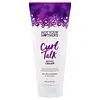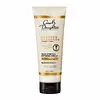What's inside
What's inside
 Key Ingredients
Key Ingredients

No key ingredients
 Benefits
Benefits

 Concerns
Concerns

 Ingredients Side-by-side
Ingredients Side-by-side

Water
Skin ConditioningPolyacrylamide
C13-14 Isoparaffin
EmollientShea Butter Ethyl Esters
EmollientPolyquaternium-10
Lactobacillus/Tomato Fruit Ferment Extract
Skin ConditioningOryza Sativa Extract
AbsorbentKeratin Amino Acids
Skin ConditioningLeuconostoc/Radish Root Ferment Filtrate
AntimicrobialAcyl Coenzyme A Desaturase
Skin ConditioningLaureth-7
EmulsifyingPg-Hydroxyethylcellulose Cocodimonium Chloride
Parfum
MaskingDisodium EDTA
Phenoxyethanol
PreservativeEthylhexylglycerin
Skin ConditioningWater, Polyacrylamide, C13-14 Isoparaffin, Shea Butter Ethyl Esters, Polyquaternium-10, Lactobacillus/Tomato Fruit Ferment Extract, Oryza Sativa Extract, Keratin Amino Acids, Leuconostoc/Radish Root Ferment Filtrate, Acyl Coenzyme A Desaturase, Laureth-7, Pg-Hydroxyethylcellulose Cocodimonium Chloride, Parfum, Disodium EDTA, Phenoxyethanol, Ethylhexylglycerin
Water
Skin ConditioningHydrogenated Starch Hydrolysate
HumectantGlycerin
HumectantCetearyl Alcohol
EmollientRicinus Communis Seed Oil
MaskingButyrospermum Parkii Butter
Skin ConditioningBehentrimonium Chloride
PreservativeHydroxypropyl Guar
Emulsion StabilisingGlyceryl Stearate Se
EmulsifyingBis-Diglyceryl Polyacyladipate-2
EmollientPhenoxyethanol
PreservativeParfum
MaskingIsopropyl Alcohol
SolventCaprylyl Glycol
EmollientCetyl Esters
EmollientNigella Sativa Seed Oil
EmollientPropylene Glycol
HumectantLimonene
PerfumingGeraniol
PerfumingLinalool
PerfumingSorbitol
HumectantPotassium Hydroxide
BufferingCitronellol
PerfumingCitral
PerfumingZingiber Officinale Root Extract
MaskingCeramide AP
Skin ConditioningWater, Hydrogenated Starch Hydrolysate, Glycerin, Cetearyl Alcohol, Ricinus Communis Seed Oil, Butyrospermum Parkii Butter, Behentrimonium Chloride, Hydroxypropyl Guar, Glyceryl Stearate Se, Bis-Diglyceryl Polyacyladipate-2, Phenoxyethanol, Parfum, Isopropyl Alcohol, Caprylyl Glycol, Cetyl Esters, Nigella Sativa Seed Oil, Propylene Glycol, Limonene, Geraniol, Linalool, Sorbitol, Potassium Hydroxide, Citronellol, Citral, Zingiber Officinale Root Extract, Ceramide AP
Ingredients Explained
These ingredients are found in both products.
Ingredients higher up in an ingredient list are typically present in a larger amount.
Parfum is a catch-all term for an ingredient or more that is used to give a scent to products.
Also called "fragrance", this ingredient can be a blend of hundreds of chemicals or plant oils. This means every product with "fragrance" or "parfum" in the ingredients list is a different mixture.
For instance, Habanolide is a proprietary trade name for a specific aroma chemical. When used as a fragrance ingredient in cosmetics, most aroma chemicals fall under the broad labeling category of “FRAGRANCE” or “PARFUM” according to EU and US regulations.
The term 'parfum' or 'fragrance' is not regulated in many countries. In many cases, it is up to the brand to define this term.
For instance, many brands choose to label themselves as "fragrance-free" because they are not using synthetic fragrances. However, their products may still contain ingredients such as essential oils that are considered a fragrance by INCI standards.
One example is Calendula flower extract. Calendula is an essential oil that still imparts a scent or 'fragrance'.
Depending on the blend, the ingredients in the mixture can cause allergies and sensitivities on the skin. Some ingredients that are known EU allergens include linalool and citronellol.
Parfum can also be used to mask or cover an unpleasant scent.
The bottom line is: not all fragrances/parfum/ingredients are created equally. If you are worried about fragrances, we recommend taking a closer look at an ingredient. And of course, we always recommend speaking with a professional.
Learn more about ParfumPhenoxyethanol is a preservative that has germicide, antimicrobial, and aromatic properties. Studies show that phenoxyethanol can prevent microbial growth. By itself, it has a scent that is similar to that of a rose.
It's often used in formulations along with Caprylyl Glycol to preserve the shelf life of products.
Water. It's the most common cosmetic ingredient of all. You'll usually see it at the top of ingredient lists, meaning that it makes up the largest part of the product.
So why is it so popular? Water most often acts as a solvent - this means that it helps dissolve other ingredients into the formulation.
You'll also recognize water as that liquid we all need to stay alive. If you see this, drink a glass of water. Stay hydrated!
Learn more about Water